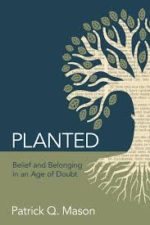Articles/Essays – Volume 49, No. 2
Planted: An Earthy Approach to Faith and Doubt | Patrick Q. Mason, Planted: Belief and Belonging in an Age of Doubt
Editor’s Note: This article has footnotes. To review them, please see the PDF below.
Planted: Belief and Belonging in an Age of Doubt by Patrick Mason is part of the Living Faith series by the Neal A. Maxwell Institute for Religious Scholarship at Brigham Young University. Announcing the series, the Maxwell Institute wrote: “Each [book] will contain the voice of a scholar who has cultivated a believing heart while engaging in the disciplines of the Academy.” Other titles in the series have included Letters to a Young Mormon by Adam S. Miller, First Principles and Ordinances by Samuel M. Brown, and Evolving Faith by Steven L. Peck. Among these titles, Mason’s Planted earned the distinction of being published jointly with Deseret Book, making it a natural follow-up to the critically-praised The Crucible of Doubt by Terryl and Fiona Givens.Planted adds to a growing body of Mormon literature that directly engages topics of faith, doubt, and reason. A historian respected for his scholarship on anti-Mormon prejudice during the nineteenth century, Mason serves as the Howard W. Hunter Chair of Mormon Studies at Claremont Graduate University and has been popular among national media outlets as a public authority on Mormonism.
Deviating from dispassionate academic writing, Planted offers a pastoral dialogue, empathetically conceding that Mormons are not immune to skepticism toward religious institutions in the “secular age” (13). In the introduction, Mason distinguishes between those who feel “switched off” and those who feel “squeezed out.” The switched off, Mason writes, “[a]re those who encounter troubling information online or somewhere else, usually regarding our history or doctrine” (2) while the squeezed out “feel alienated by things like the dominant political conservatism among members . . . or the sense that church member ship is an all-or-nothing proposition” (3). Those who are switched off may be triggered more by historical issues, such as polygamy or racism, while those who are squeezed out may be triggered more by contemporary cultural issues, such as support for feminism or LGBT equality. Mason clarifies that his approach to doubt is from a position of belief and certainty but humbly admits that “certain aspects of the church’s past and present” still trouble him (10). Mason’s tone of humility and candidness throughout is what sets Planted apart on issues of faith and doubt and distinguishes the writing as pastoral rather than apologetic.
Planted can be divided up into “acknowledgments” and “admonitions,” with the first two-thirds of the book focused on the reality of pain, struggle, and the issues that cause them. Mason normalizes doubt, acknowledging that it “seems deviant” within Mormonism (17), but quipping that “[h]onest doubt is not just a phase, like teenage acne or disco” (19). At the same time, Mason’s stance is that knowledge will always be imperfect and that members must learn to both “live with loose ends” and “have hard conversations” in our present age (23). In the chapter titled “Foolishness and Scandal,” Mason admits, “Mormonism does demand a willingness to appear the fool in the face of exclusivist rationalism” (57), which is not to suggest that belief is foolish but rather that it is the nature of religion to depend upon belief in the extraordinary. Nuancing The Crucible of Doubt’s call to “commitment that is born of faith freely chosen rather than certainty compelled by evidence,”Mason reasons, “There are many people for whom faith or doubt appear more as an unearned inheritance than a personal choice” (33). Acknowledgments such as these lend a pragmatic earthiness to Planted, showing that Mason is not afraid to dig his hands into sacred soil that other writers may fear too hallowed to stir.
Mason makes his most profound plea in the chapter “In All Patience and Faith.” Following two chapters on candid approaches to Church his tory, the topic shifts to prophetic fallibility. Mason asks, “Can a prophet be inspired and in error, even on the same day or in the same sermon?” (110); “Can I believe that God leads the church through flawed prophets?” (113); and, profoundly, “Can I forgive prophets for their faults, even their occasionally severe ones, and be patient with my brothers?” (113). Following this, Planted shifts in tone from acknowledgment to admonition. Mason declares, “We do not place our ultimate hope in prophets and priesthood leaders. We do not place our ultimate hope in the church. We place our ultimate hope in Christ and his atonement” (125). “The church,” he states, “is not a final product delivered straight from heaven to earth”; rather, it is “inseparable from, and defined by, the lives and actions of its members” (135). Using as a blueprint Eugene England’s influential personal essay “Why the Church is as True as the Gospel,” Mason spends the remaining pages of Planted calling for a local centric approach to Church membership, with the attendant challenges and joys of participating in a local congregation.
Where The Crucible of Doubt is poetic and grounded in romanticism, Planted is pragmatic and applicable to a postmodern age of skepticism, thus making it a nice complement. Those who may have found the Givenses’ prose too lofty may find Mason’s utilitarian style more relatable. Significantly, the publication of Planted shows a continued interest from Deseret Book, as well as scholars, to reach out to members who may find themselves marginalized due to their sincere questions and doubts. I recommend Planted for those who need an empathetic voice and those who want to develop an empathetic voice for others.
Patrick Q. Mason. Planted: Belief and Belonging in an Age of Doubt. Salt Lake City: Deseret Book, 2015. 215 pp. Paperback: $15.99. ISBN: 9781629721811.


 Back to full Issue
Back to full Issue

